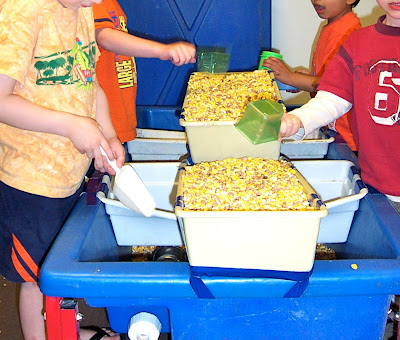So if one tray is good, then two must be better.
There are now two trays, but how many spaces? Two trays multiplies the spaces in which the children work. Besides the over, under, and in of each of the trays, there is now an inbetween. Now, too, there is another container from which---or into which---to transport.

So if two trays are better, then three trays must be even better, still.
Besides the planter tray in the middle, I found some old dark room trays. I was able to arrange one of the darkroom trays so the bottom on one side rested on the lip of the planter and the bottom on the other side rested on the lip of the sensory table. With this arrangement, there are more levels and more spaces to explore. There are now three levels inside the table and spaces on either side of the trays, over the trays and under the trays.
If three trays are better still, then five trays...well, you get the idea. Once you start, there are any number of combinations and orientations.

There are now four levels inside the table and plenty of novel spaces. And the children will use all the levels and spaces in their play and exploration.

These children said they were filling the top trays with all the seeds. Could they do it? The answer is not as important as the process. First they gave themselves a task and pursued it with the utmost importance. Why this task? I think it has something to do with their innate drive to transport. They worked very hard even though gathering all the seeds from all the spaces involved more complex operations, like scooping the corn from the bottom trays. This involved first scooping with spoons under the top trays, pulling the scoops back and then lifting and pouring into the top tray. The spoons lost their usefulness because the bottom of the bottom trays are not flat and the children were getting fewer and fewer seeds. Next, they started to use their hands to grasp the seeds. When I look at the picture, I think of the feeling of space, particularly depth, they are experiencing as they reach all the way under the tray to get the seeds. That is not only the vertical depth of reaching into the tray, but it is also a horizontal depth of reaching way under the tray.

As they scoop and scrape, they are constantly gauging their progress. How much is left in the bottom of the trays and the bottom of the table? How much more do is needed to fill the top? In this episode of play, they worked very hard. The top tray was full, so they went on to the next level to fill those trays.
They could not get every seed out of the bottom trays and out of the bottom of the table, but their work was impressive. By filling the top trays, they were able to see the effect of full trays and the weight on the base trays.



















